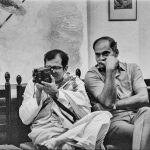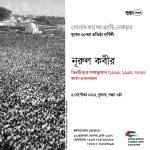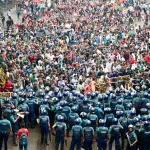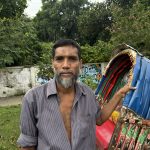VOICE OF BANGLADESHI IDENTITY
Ina Puri | March 9, 2013 The Times of India

A prominent voice of Bangladeshi identity, Shahidul Alam has garnered acclaim for documenting his nation?s many struggles. As an activist and photographer, he has distinguished himself in international art gatherings, winning accolades for his work that has sought to narrate the story of pain and hopelessness, of the need to fight for justice. He has also founded Majority World, a photo agency that looks to promote talent in Third World nations. TOI-Crest catches up with Alam at the Kochi Biennale.
What are your thoughts on the present uprising in Bangladesh?
They call Shahbagh, projonmo chottor (‘ generation square’ ) – a generation that hasn’t seen 1971 but believes in its ideals. For once political parties are not at the centre-stage. Standing amid the crowd, breathing in the air of hope, I see children in bright clothes, a woman in a wheelchair, an old man with henna-dyed beard and exuberant youth with hope in their eyes. We must not see the movement as merely a demand for blood or revenge. This is a call to re-appropriate the slogan ‘Joy Bangla’ from the politicians back to the people.
When did the romance of the 1971 Liberation War end and when did collective disillusionment begin?
The dream and quest of ’71 never ended, because the war never ended. It was a war to set our people free. Not only from the occupying Pakistani military, but also from the yoke of poverty and religious bullying. The Pakistanis have gone, but until the farmers, garment workers and migrant labourers of my land, the true heroes of my nation, can lead dignified lives where they have a say in the process of governance, the war will continue.
How do you see Bangladesh in an ideal world?
Bangladesh is a land of poets and philosophers;a fertile land with bountiful rivers. It is also a land where many live in hardship, despite great toil. The Bangladesh I’d like to see would provide for the common man and woman. Here creativity would be cherished and differences celebrated. Rice and laughter would both be shared.
The Brazilian photographer Sebastiao Salgado writes about your photo agency’s mission: ‘Majority World was created to support photographers in emerging countries, to help them make their work known outside their own borders. . . ‘ How far have you been successful in forging a virtual community that reiterates its faith in one’s self?
There have been some gains, but we have a long way to go. Majority of the photographers now produce powerful work, which is represented by Majority World, Drik and other agencies. Festivals like Chobi Mela also showcase their work. Wire agencies work far more with local photographers than they used to. But until the power structures within media is changed, the Majority World photographer will remain lower down both the power chain and the food chain. There are those who have produced in-depth, meaningful work that is important for the community. But inevitably, there are also those who have taken the easy way out, producing work as per demand.
The Chobi Mela is an interesting phenomenon. What led to its creation? Is funding a problem?
Chobi Mela evolved from the belief that all artists are citizens of the world who need to be part of a mutually stimulating environment and informed by broader cultural practices. They need to provide and provoke. Their ideas need to be questioned and nurtured. But globalisation has strange rules. It provides mobility for money and goods, but barriers for people. At least for some people. While artists from wealthier countries can travel at will, treating our countries as their backyard, the reverse is quite impossible. Even if one were to raise the money needed for such mobility, immigration laws would make it impossible for the average majority world artist to participate in festivals in minority lands. Chobi Mela is an inclusive festival. While funding is a serious issue, we make sure our limited resources are used to provide maximum opportunity for participants from Latin America, Africa, Middle East and Asia to have the opportunity to showcase their work.
Your voice brings global attention to the crisis in Bangladesh – the killings, corruption. For this you have been assaulted, threatened, jailed. Have you never been afraid?
I haven’t been knifed since 1996. Yes, fear is a constant companion, but it is a companion I would not do without. It tells me that I am working at the frontier, which is where I belong. I am never hopeless as I believe in the power of many and cherish the power of one.
Tell us about your most recent project – the travails you went through to trace the disappearance of a Chakma girl decades ago.
We fought for the right to speak our own language, yet we deny that right to citizens of our own land. Kalpana Chakma’s struggle and her disappearance is a scar in our history. It is remarkable that no photographer has so far attempted to address this crucial story. Telling the story of a person who was last seen 16 years ago is a challenge in itself. To produce work that can potentially challenge military impunity requires both scientific rigour and artistic poise, reaching out to both the heart and the head. It has involved extensive research and a talented team as well as facilities in Australia, UK, Germany and of course, Bangladesh. There are no guarantees that we will pull it off, but it is an attempt that has to be made.





Leave a Reply
You must be logged in to post a comment.